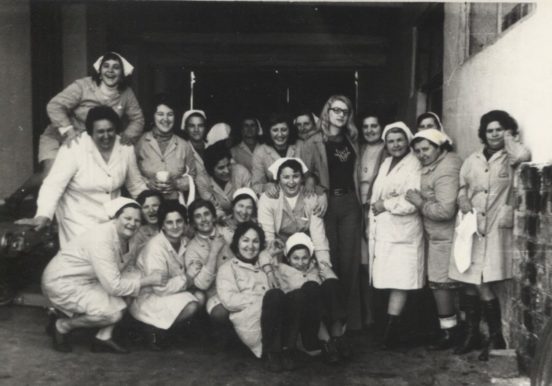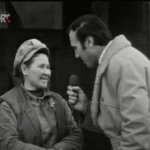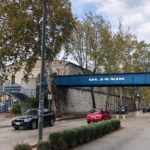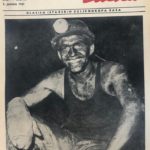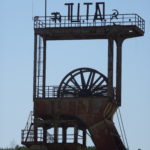In early December 2019, the daily Glas Istre reported on Fažana, a small town situated across from the Brijuni Islands and north of the city of Pula, with which it is closely connected via daily migrations. The topic of the three published articles was not a new one, but on this occasion it seemed that there might be a final outcome to a case that had been an unsolved urban and development-related problem for fifteen years, pertaining to the very centre of this small municipality in Istria. More specifically, there is a former industrial zone linked to the old centre of Fažana. At the endpoint of its existence, this zone consisted of two factory branches: the Zagreb based “Marijan Badel”, a factory of alcoholic and soft beverages, and the Pula based glass factory “Boris Kidrič”. Both of these names were active communists during the Party’s illegal period in the interwar Kingdom of Yugoslavia. Kidrič was one of the leading Slovenian and Yugoslav politicians soon after World War II and the ideologist behind the system of workers’ self-management, while Badel died as a political commissar and partisan fighter in central Croatia and was later proclaimed a national hero. Both personalities disappeared from post-socialist Fažana’s public space, as did the factories named after them – first their lively working collectives and later the production halls themselves. While the parent company plants in Zagreb and Pula are still operating, the latter one albeit under a new name, their plants in Fažana, situated only a few steps from the sea shore, have become a part of local industrial history. The space they previously occupied is today only a wasteland awaiting a new function. Interestingly, a similar void exists in contemporary practices of local identity construction, in directing the memory culture and in tourism branding. In these practices, the second half of the twentieth century remains largely unrecognised and therefore adopts the features of a silenced and undesirable history. Why is that so? Why has post-industrial consciousness escaped from the industrial twentieth century and opted for the almost pastoral and idyllic safety of the premodern and preindustrial period? Is socialist industry the only issue in Fažana’s public memory culture, or was the same status shared by the petty and middle entrepreneurial class of the first industrialisation, which occurred during the Austro-Hungarian turn of the century?

“Production […] Seven Times Bigger”, “Fažana Grows Days After Day”, “The Nice Prospects of a Small Collective”, “Fažana Has Planned Well” – as Glas Istre optimistically and enthusiastically reported in the 1950s.[1] In the years of the socialist Yugoslavia’s rapid industrial development, Fažana also underwent a fast-paced industrialisation and urbanisation. In the town’s modern and contemporary industrial history, this was the second and last episode, which – relying strongly on everything completed since the construction of the first plants in 1880s Austria-Hungary – introduced new industrial sectors and decreased the share of fishing and agriculture in the local economy. However, with a tradition longer than a century, Fažana’s factories were shut down during the process of a post-Yugoslav transitional deindustrialisation. Working on a conveyor belt stopped being a desirable symbol of modernity and so the rusty factory remains were demolished after they had acquired the image of being an unwanted eyesore situated by the sea shore and next to the town centre.
A new opportunity for economic development did not require a long search, since the chance that imposed itself was not previously unheard of. The basis for future tourism development emerged on Brijuni in the 1890s, only some ten years after modern industry had appeared on the nearby mainland. Being, so to say, peers in this locale, industry and tourism stood side by side, sometimes supporting each other, while on other occasions disturbing one another. Both sectors certainly contributed to the population increase in Fažana – from 413 in 1857, to a thousand more in 1910 and triple (3,569) a century later.[2] However, this growth was not linear, because of demographic stagnation in the interwar period under Italian rule. Moreover, the Yugoslav post-war period brought with it emigration and immigration, as a result of which by the 1953 census Croats had become the majority and Italians the minority, with the total population dropping to only 765 and only overtaking the historical maximum from the beginning of the century with the 1971 census. At the same time, Fažana went through a period of emerging mass tourism in a specific way. In the 1980s, the number of overnight stays reached 300,000 per year, with as many as three quarters in social tourism and with almost exclusively Yugoslav guests.[3] These data significantly differ to the Municipality of Pula or the Croatian national level where foreign and commercial tourism prevailed as early as in the 1960s. In its century-long history of tourism, Fažana found itself in a rut: on the one hand there was Brijuni as an elite and closed destination for European high society, which later became the residency of the Yugoslav president Josip Broz Tito and finally a national park from 1983 onwards; on the other hand there was an almost half-a-century long tradition of low-cost resorts for children and domestic guests. In this relationship spanning open and closed, domestic and foreign, tourist and industrial, the winner was foreign commercial tourism, which recently succeeded in reaching over a million overnight stays in Fažana.
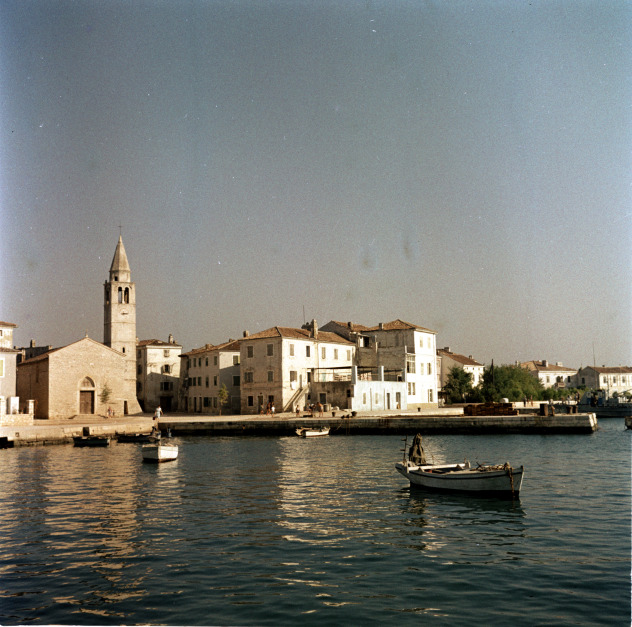
Fažana, probably 1961 (HDA Agefoto) 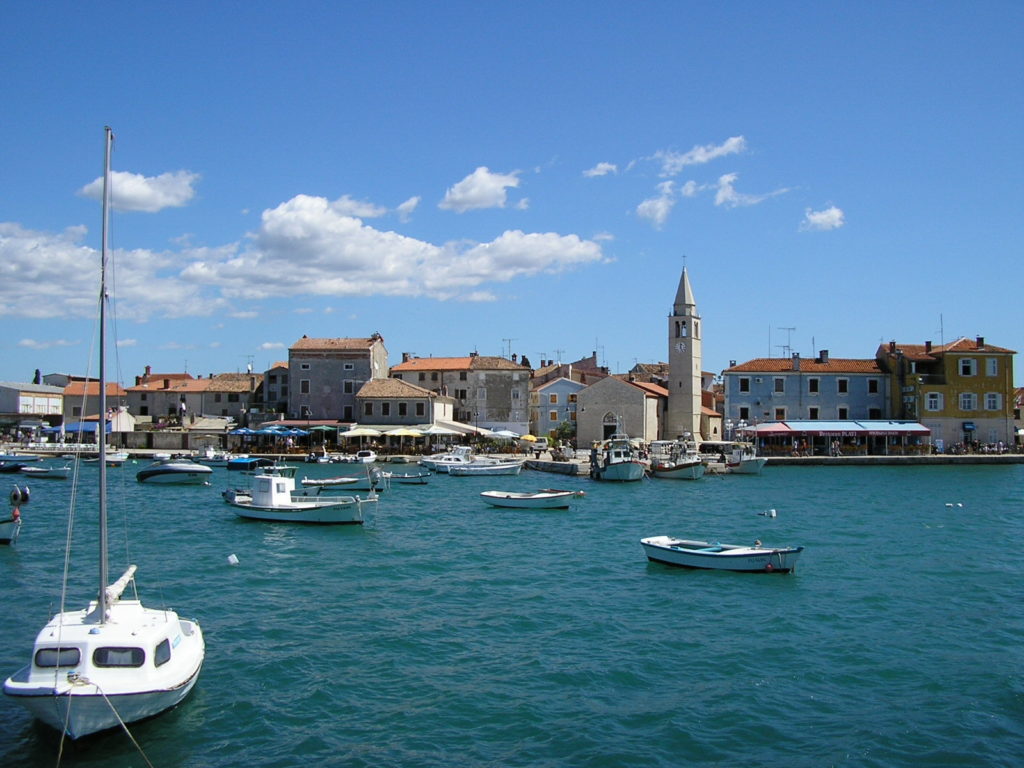
Fažana, 2004 (author’s collection)
Industry as a living organism
Although the space for new research remains broad, basic data on the history of industry and tourism in Fažana, as well as various local historical details, are already known. In 2001, a very brief summary of the economy was published in the Croatian Encyclopaedia, whose article on Fažana mentioned ancient amphora production, but also: “food (non-alcoholic beverages) and glass (light-glass) industries”.[4] In 2005, the Istrian Encyclopaedia, by the same publisher, revealed more of the town’s industrial and social history – a text that was transferred to the online Istrapedia four years later and has not been updated since then.[5]
The population (3,050 in 2001) works in agriculture (viticulture, olive growing), fishing and fish processing, some in industry, the construction of small fishing boats and tourism. In Fažana there was a light-glass factory, fish-processing factory, factory of alcoholic and non-alcoholic beverages (Badel) etc., but industry disappeared in the 1990s. In the hinterland there are orchards, vineyards and olive groves. […] The town started to develop again in the early twentieth century when Brijuni became an elite tourist destination. In the second half of the twentieth century it was closed for commercial tourism due to the safety of Tito’s residency on Brijuni. Nevertheless, it was surrounded with military, police, Party and children resorts. In this period Fažana grew rapidly due to the post-war housing construction, including flats and houses for numerous Brijuni workers. There was an active social life (cinema, dancing etc.). When Brijuni was opened for tourism in the 1980s, Fažana again flourished and developed. In the last decade Fažana and neighbouring Valbandon witnessed a flourishing of commercial tourism. In the town there is a kindergarten, an elementary school, a doctor’s surgery, a post office, a bank etc.[6]
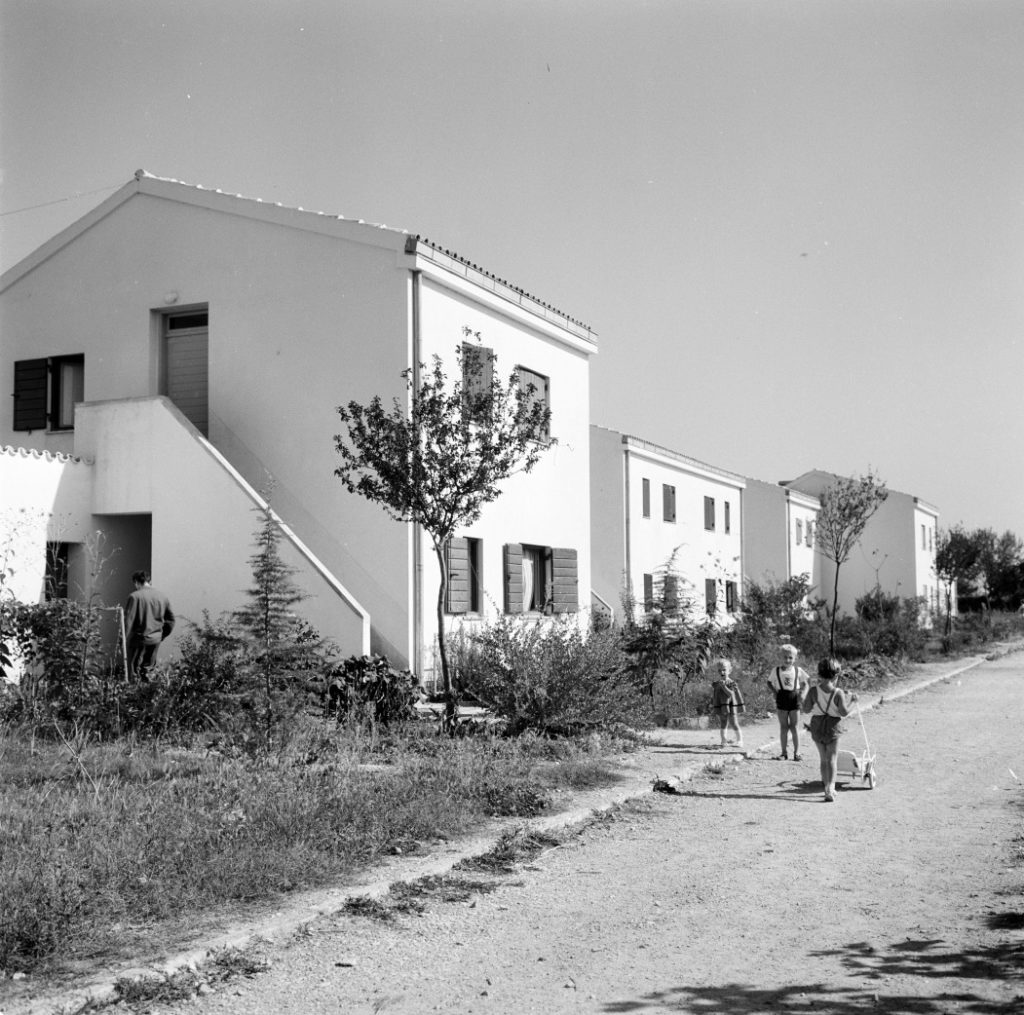
Annual conferences held in Fažana between 2006 and 2014 contributed most to knowledge on local history. Proceedings were published in Fažanski libar, a series of seven volumes edited by Mirko Urošević. The key articles on industrial history were written by Giancarlo Moscarda and Alida Perkov, and they form the basis for the following short overview.[7]
By the late nineteenth century, industry in Fažana had gained its first contours, mainly thanks to investments from Central Europe and to the entrepreneurial members of the Marinković family who came from Komiža on the island of Vis in Dalmatia. In 1884 in Fažana the Czech–Austrian businessman Karel Varhánek/Carl Warhanek opened one of his seventeen fish canneries. In 1897 Rudolf Marinković/Rodolfo Marincovich/Marini invested in a liquor factory and distillery named Premiata distileria e fabbrica liquori. The family also owned a hotel, a restaurant and a printing house, while one of its members, Giacomo, opened a factory of vinegar and candies in 1905. In those years Vittorio Privileggio produced a soft drink called passaretta. Shortly before World War I there was a shipyard owned by Giovanni Marini. This first wave of industrialisation laid the foundations for the factory branches that later characterised the town’s economy: fishing and fish processing, the production of alcoholic and soft beverages, shipbuilding.
In the interwar period, under Italian rule, Warhanek’s factory was taken over by Società anonima prodotti alimentari D. Arrigoni & C. from Trieste. After World War II, it belonged to the state-owned fish-processing factory from Banjole, south of Pula and production continued until 1953. Nationalisation and organisational restructuring, implemented by Yugoslav socialism, were also present in other industrial plants and sectors. The modernisation of agriculture was driven by the Institute of Adriatic Cultures, later named the Agricultural Institute, and finally – since 1962 – by the Agricultural Cooperative of Fažana. In the industrial sector, 1947 saw the establishment of the liquor factory and distillery, which was named Tvornica likera Fažana in 1949. Due to financial difficulties and liquidation, in 1963 it was taken over by Badel from Zagreb, which started the production of Pepsi Cola in the 1970s and remained there until the end of the century. In the 1950s the liquor factory was transferred into the empty spaces of the former cannery and broom processing factory. The latter was founded in 1951 as a successor of a testing station for broom processing, which was founded in 1947 by the General Directorate of Textile Industry of the People’s Republic of Croatia. However, investments in the plantation and production were unsuccessful and therefore the business was liquidated in 1951–52. In 1961, next to the liquor factory, a division of the Pula based shipyard Crvena zvijezda (Red Star, later Tehnomont) was opened, lasting for a few years. Its empty spaces were then taken on by a glass factory from Pula. Thus, Badel and the Kidrič glass factory became the main and only pillars of Fažana’s industry up until the 1990s.
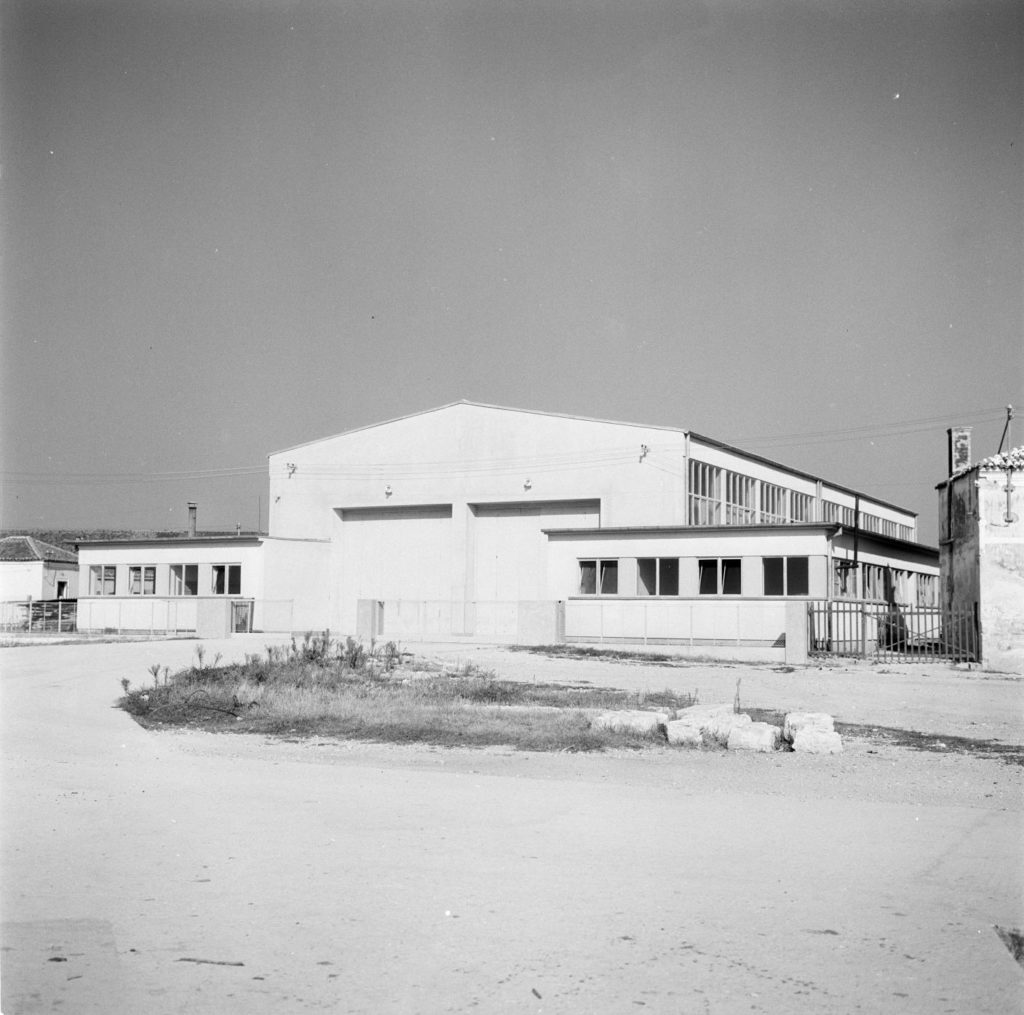
Future glass factory, early 1960s (HDA Agefoto) 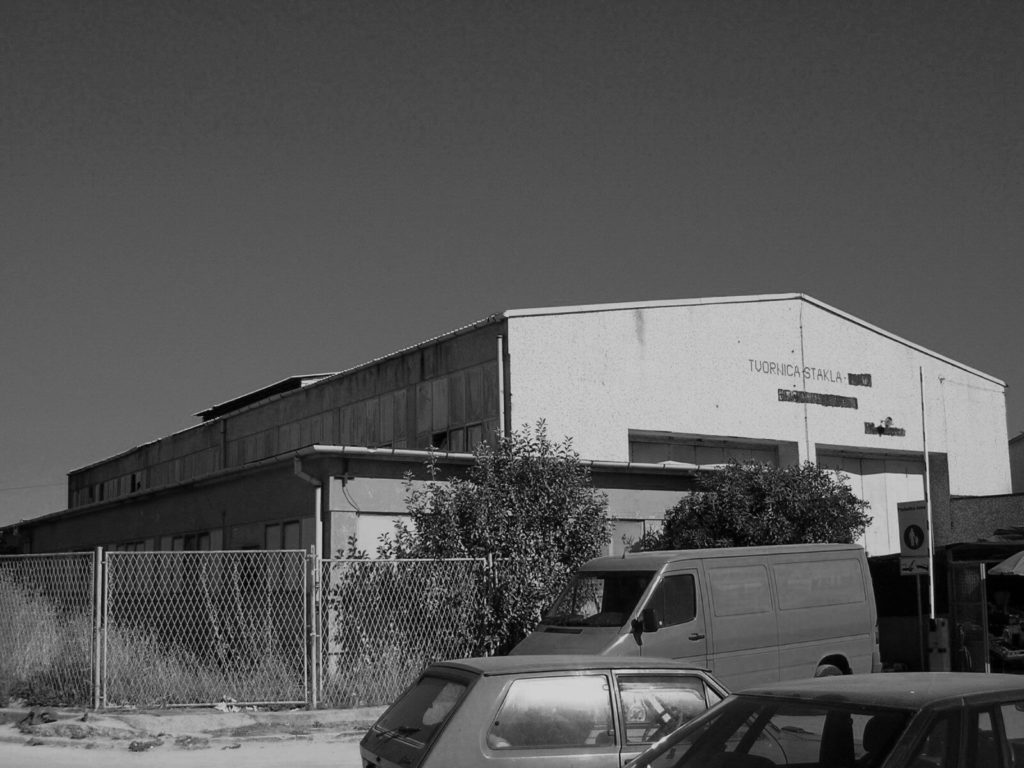
Former glass factory (front view), 2004 (authors collection) 
Former glass factory (back view), 2004 (author’s collection)
The struggle for space
The industrial zone was shaped in the 1950s and 1960s in the area that was partly used by the Brijuni Islands Administration up until 1959. It had a workshop, a garage and a boat house. The Administration, as well as the Office of the President of the Republic and the municipal authorities in Pula, were responsible for the development of Fažana at that time. During the takeover of this future industrial complex, the Municipality of Pula acted in accordance with an expert opinion:
To answer the question of how to use these industrial buildings, apart from the factors of functionality and rationality, we have to also take into account the factor of the suitability of the chosen industry with regard to the surroundings and Fažana as a seaside tourist town and especially the proximity of Brijuni. Since the built complex is quite large, it is clear that the type of chosen industry will make a mark on the town itself. So, we have to keep in mind that this new industry does not damage the seaside tourist atmosphere. Therefore, we have to choose an industry that will create an impression of a modern town in an industrially developed country, but at the same time keep the peace because of the vicinity of the Brijuni Islands. If we agree on this, there can be only one outcome: the chosen industry has to be related to the sea and shipbuilding.[8]
At the end of the zone’s existence, under quite different circumstances, the new Municipality of Fažana also took into account the seaside and tourist atmosphere. It was anticipated that spatial planning from 2002 would “stimulate the conversion and redesigning of the area of Lura-BAP and the Istrian Glass Factory into a high-quality residential, tourist and service complex”.[9]
Although summer events in Fažana are regularly discussed in the media, from time to time during the last fifteen years the local and national media has also devoted attention to the final remains of the industrial zone and its future purpose.[10] The last news item contributing to a presentation of the town’s industrial history appeared in December 2019.[11] After fifteen years of disputes over the extent of the new constructions, the municipal council accepted a plan for the 1.6 hectares of the former industrial zone and thus interrupted speculation over the future appearance of this area. After having abandoned the production halls, the Italian firm Robustus bought the property in 2003/2004, selling it in 2006 to the Israeli firm Liberty. The latter’s intention was to build extensive tourist facilities, but the new municipal spatial plan prevented this and the municipality characterised such intentions as exaggerated and inappropriate. There was even a trial that the municipality won and, according to the verdict, it was not found responsible for Liberty’s loss of expected profit. In the meantime, the buildings continued to deteriorate and in 2014 the ruins were completely cleared due to health, safety and aesthetic reasons. The most recent deal with Liberty, which has changed owners in the meantime, permits a smaller construction that will, according to designs by an architects’ studio from Rijeka, be in harmony with the old town centre and include residential buildings with 73 flats, office space, an underground garage with 330 parking spaces and a hotel with 150 beds. The new quarter should not disturb the town’s sea view: its streets will consist of an extension to the existing network and there will be no fences. What follows is a building permit and the start of construction, which will turn the cleared flat area of the former industrial zone into a new residential and tourist quarter. Hopefully, the new streets will not be empty too often: the majority of flats will be permanently inhabited, and everyday town life will continue all year round.
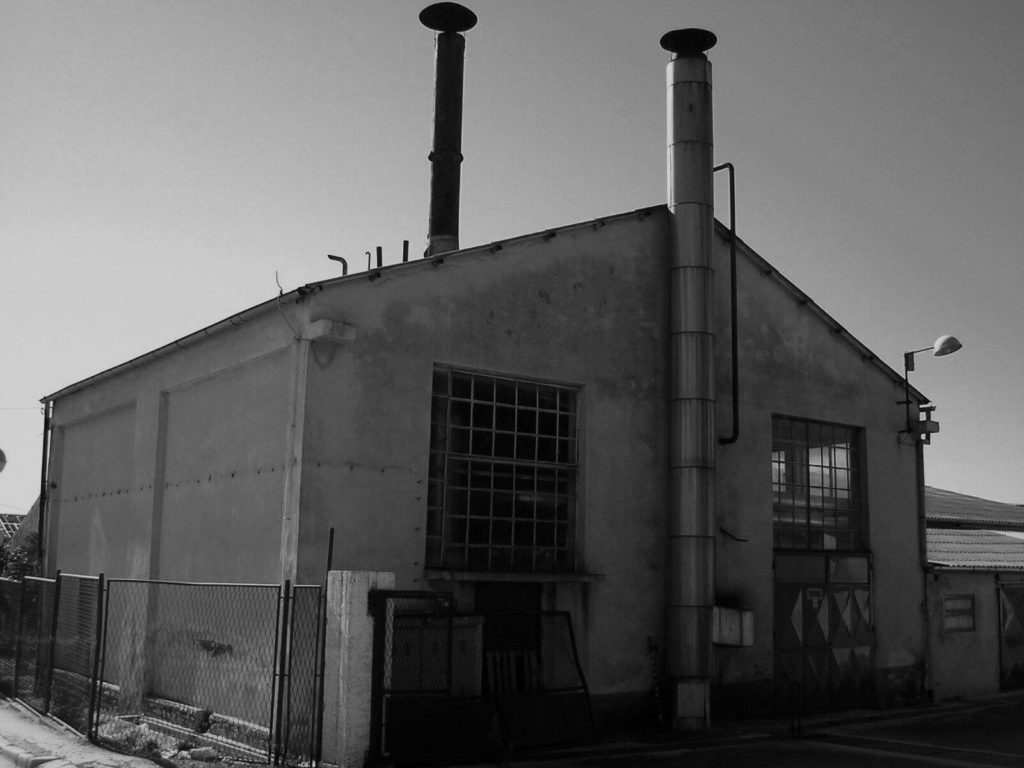
Badel, 2004 (author’s collection) 
Badel ruins (outside view), 2013 (author’s collection) 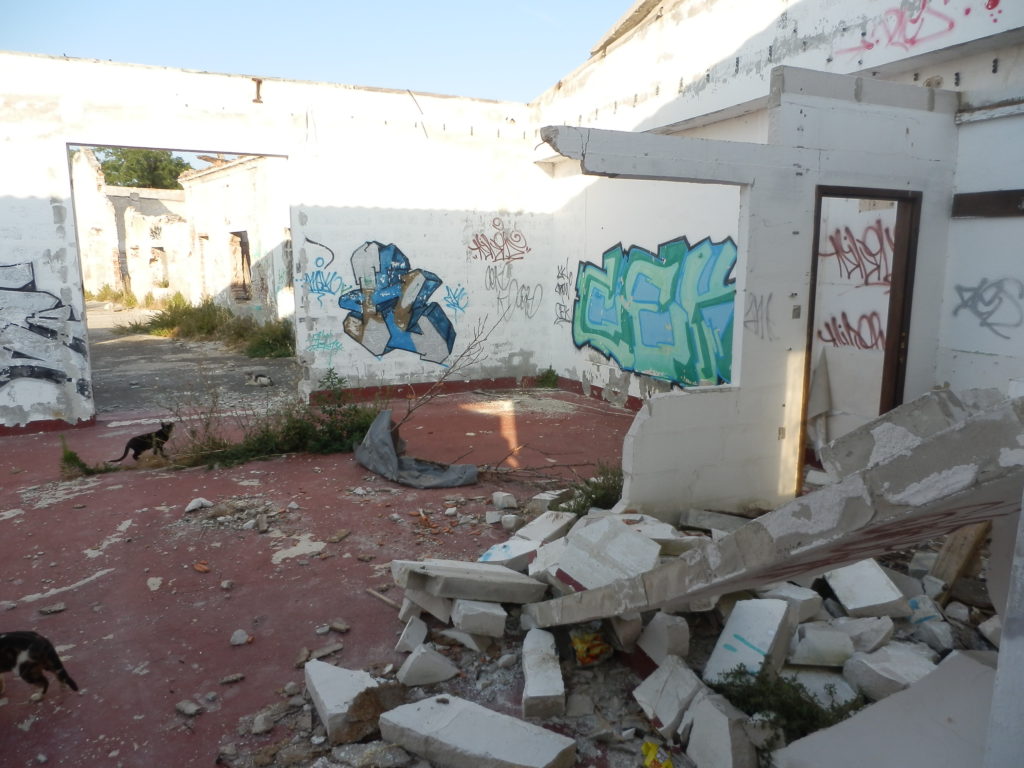
Badel ruins (inside view), 2013 (author’s collection)
Industrial heritage and tourism
As tourism has become key to development, the activities of the local tourist board, united under the slogan “a magical small town”, have become more important. The board’s web pages also offer information on cultural heritage and within this content there is a section named Fažana through History. It is a short overview of history, in five sections with texts that are uneven in length and style and that mainly lean on volumes of Fažanski libar. The first chapter, divided into five sub-pages, is named Fažana in the Roman Period and it points out the olive groves, as well as the production of oil and amphorae. The following chapter is on the Middle Ages when the economy of this “rural and urban centre” depended on “cattle breeding and farming, but also fishing and maritime trade”.[12] The chapter The Austro-Hungarian Period, with its introduction and seven sub-pages, reminds the reader of the prosperity made possible by Brijuni from the late nineteenth century, and includes a lot of information on military history and connections with the naval port of Pula. This watershed in economic development is presented on a separate sub-page: “The transformation of Fažana from a small, poor fishing town to an economic center and favorite tourist destination was considerably fast, as a result of the increased development of south Istria at the turn of the 19th and 20th centuries.”[13] One can find here both Carl Warhanek with his cannery and Paul Kupelwieser with the Brijuni Islands. A separate sub-page presents the Marinković family whose members were “all entrepreneurs who engaged in many business activities related to the increasingly popular tourism”.[14] Independently from them, a fish-processing and ice-making plant operated in the neighbouring Valbandon at the beginning of the twentieth century, but the plant reoriented toward tourism.[15] One might say this was an early heralding of certain future trends. The fourth chapter in Fažana’s history – The Period of Italian Rule – is a differently structured and unedited text that mainly lists data on social and economic history, but also gives a positive impression of the period that can be summarised by the phrase “amazing boom”:
Continuing the trend of tourist development, Fažana experienced a true economic boom between the two World Wars. In 1930 there were 1100 inhabitants living on an area of 2000 hectares. Apart from the very well-developed receptive tourist infrastructure such as 2 hotels, 13 restaurants and inn, 3 garages and gas station, there were also a number of factories: fish processing plant, toffee factory, production plant of liqueurs, shipyard, mineral water bottling plant… An interesting fact is that such a small town as Fažana had its post office, telegraph, telephone, elementary school and kindergarten, police station, town doctor, veterinarian as well as regular connections to Pula, Vodnjan and Rovinj.[16]
World War II marked the beginning of a period completely unknown to the web pages of the tourist board, and which therefore may be of absolutely no importance for contemporary tourist promotion. After skipping half a century, the fifth and last chapter named Municipality of Fažana presents the period after 2001 when Fažana split off from Vodnjan and was founded as an independent administrative unit.[17] The new municipality is 13.86 sq km large and its economy is based on “tourism, wine and olive growing, fishing and other accompanying activities”. All of these activities have found their place in tourist promotional materials and open-air programmes that keep the traditional culture alive.
However, what about the period between World War II and the beginning of the twenty-first century? What about the period in which Fažana was shaped by its present inhabitants and their direct ancestors? Do they have something to offer to both history and tourism? On the tourist-board web pages, tiny bits of this history protrude from the post-war destiny of the Marinković family and a more recent event. The history of Fažana’s leading entrepreneurs ended in “1947 when the liquer factory and destillery ‘Premiata distileria e fabbrica liquori’, opened by Rodolfo in 1897, was nationalized”.[18] At the same time, “when Istria became part of Yugoslavia, most of them [entrepreneurs] left Fažana as part of the exodus”.[19]
Nevertheless, the factories survived as state property: Warhanek’s became part of another local fish-processing factory, while the distillery and liquor factory “closely guarded its original recipes for a long time after, proudly indicating on the product labels: ‘ex Marincovich’.”[20] Little is revealed of this long time after on the tourist-board web pages. There is just a short notice on Tito’s Days, an “event in memory of Josip Broz Tito in Fažana”, organised every year in May by the Josip Broz Tito Society and the municipality.[21] The tourist board, as the event’s co-organiser, in its 2018 annual report described Tito’s Days in five lines, mentioning a philatelic exhibition, a meeting of the J. B. Tito Societies, as well as a cultural and artistic programme.[22] The report mentions industry only alongside the adjective tourist, while heritage is never linked to the adjective industrial. There are no programmes that would bring the locals and tourists closer to the town’s recent history or the broad modernisation processes during which between 1948 and 1991 the population increased by two thousand or by three and a half times.
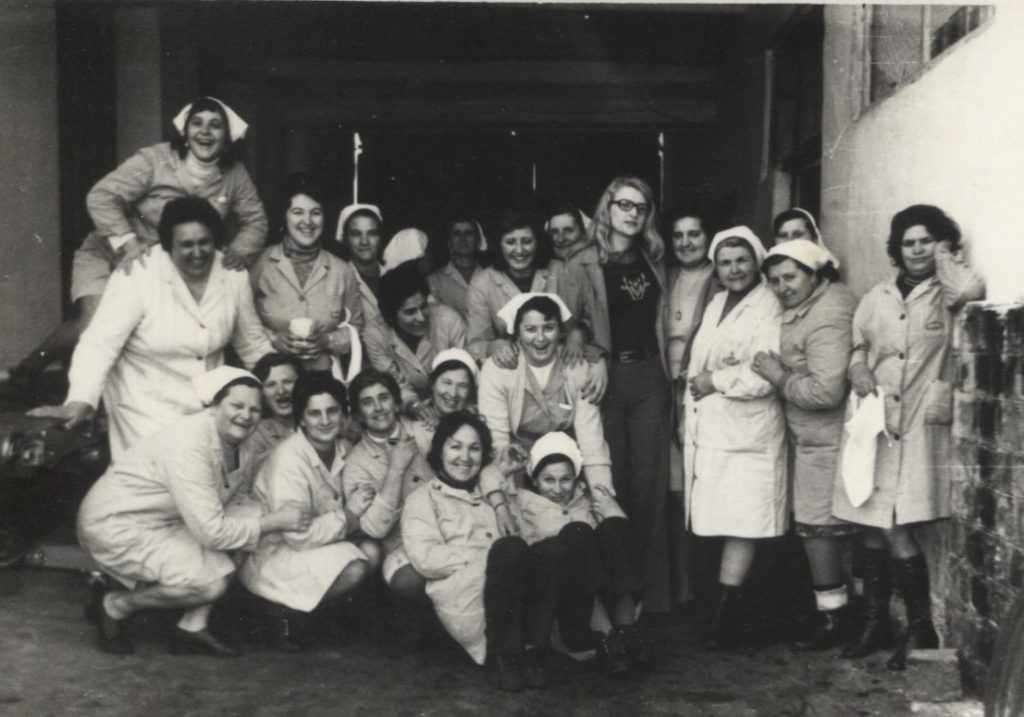
Badel workers, 1970s (author’s collection) 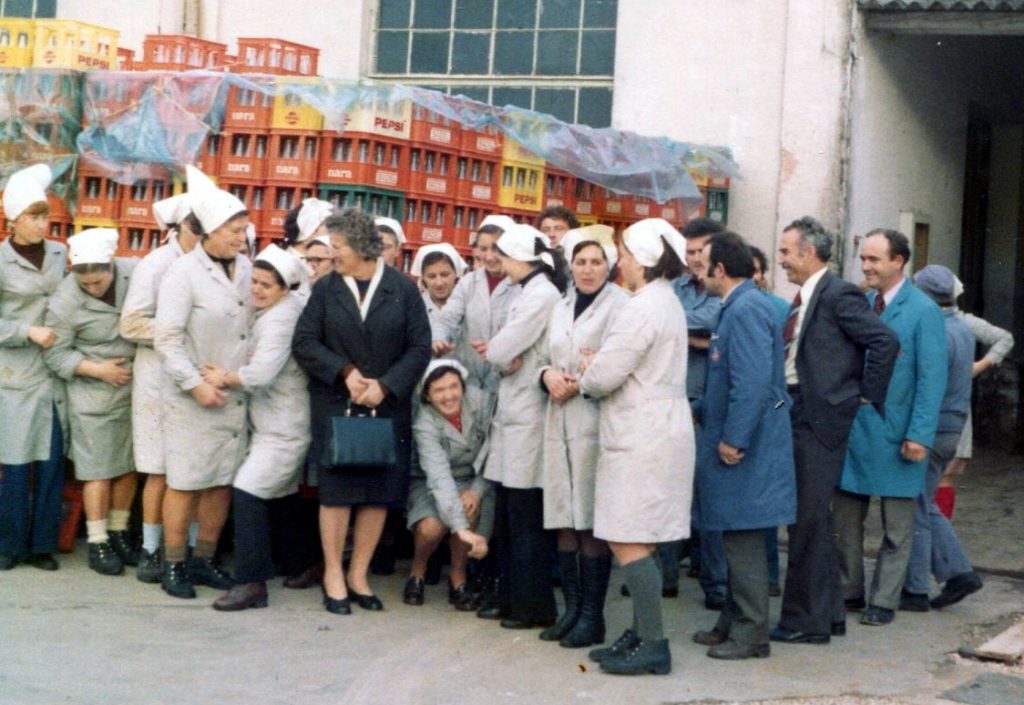
Badel workers, 1970s (author’s collection)
One can conclude that for now Fažana has not succeeded in including in its image the industrial history or its development in socialism and early post-socialism. In the town’s presentation there is not a single word on the social and political background to the migrations and the post-war shaping of a new local community, on urbanisation and housing, the construction of the public and social standard buildings, social tourism and interactions with the resorts, the layers of connections to Brijuni, female and male factory workers, their lives and products. The silencing of the second half of the twentieth century – furthermore in a municipality under the rule of social democrats – cannot be undone by regular maintenance of the monument to the fallen partisan fighters, the Tito Seafront, i.e. the town centre, or a nostalgic event in honour of the late president. All these certainly belong to Fažana’s contemporary history but are not points that should constrain it, nor markers that drain this history in all its extent. The production of knowledge within the humanities and policies regarding knowledge transfer to the public should be aware of this detail.
Igor Duda is Associate Professor at the Juraj Dobrila University of Pula, with interests in social history and the history of everyday life of socialist Yugoslavia, history of leisure and tourism, history of consumer culture and history of childhood.
[1] „Proizvodnja u tvornici likera Fažana povećana za sedam puta“, Glas Istre (GI), 31.12.1954.; „Fažana raste iz dana u dan“, GI, 4.7.1958.; „Lijepe perspektive malog kolektiva“, GI, 7.11.1959.; „Fažanci su dobro planirali“, GI, 10.7.1959.
[2] Državni zavod za statistiku, Naselja i stanovništvo Republike Hrvatske 1857.-2001., www.dzs.hr.
[3] Dokumentacija: Promet turista u primorskim mjestima/Promet turista u primorskim općinama, Republički zavod za statistiku SRH, Zagreb, 1967-1991). Više o turizmu: Urošević, Nataša, „The Brijuni Islands – recreating paradise: media representations of an élite Mediterranean resort in the first tourist magazines“, Journal of Tourism History, 2014, 2-3, 122-39; Duda, Igor, Igor Stanić, „Tanned guardians, followers and pioneers. Yugoslav directed tourism across Tito’s Brijuni Islands“, Journal of Tourism History, 2014, 2-3, 174-93; Duda, Igor, „Komunisti kao turisti. Godišnji odmor u vili CK SKH u Fažani“, Fažanski libar 7, ed. Mirko Urošević, Amforapress, Pula, 2014, 137-45.
[4] There are no changes in the online version: Hrvatska enciklopedija, Leksikografski zavod Miroslav Krleža, Zagreb, http: //www.enciklopedija.hr/Natuknica.aspx? ID=19108.
[5] Istrapedia, https: //www.istrapedia.hr/hr/natuknice/747/fazana.
[6] There are no changes in the online version: R. Matijašić, I. Duda, „Fažana“, Istarska enciklopedija, Leksikografski zavod Miroslav Krleža, Zagreb, http: //istra.lzmk.hr/clanak.aspx? id=849.
[7] Giancarlo Moscarda, „Gospodarstvo Fažane u 20. stoljeću“, Fažanski libar 2, ed. Mirko Urošević, Amforapress, Pula, 2007, 177-96; Alida Perkov, „Fažana na rubu zone A i B“, Fažanski libar 3, Amforapress, Pula, 2008, 71-81; Alida Perkov, „Gospodarstvo Fažane s početka 20. stoljeća“, Fažanski libar 7, Amforapress, Pula, 2014, 177-96. An example of the newest research is the essay by Sara Žerić, written within this project, but also her M.A. thesis which is due in 2020.
[8] Cf. Duda i Stanić, 2014., 6 (HR-DAPA-104, Narodni odbor Općine Pula, kutija 652, NOO Pula, Stručno mišljenje o mogućnosti iskorištenja objekata u Fažani, 12.12.1959).
[9] Aldo Nefat, „Prostorni plan uređenja Općine Fažana“, Fažanski libar 2, Amforapress, Pula, 2007, 127.
[10] E.g. „Izraelci zainteresirani za staklanu i Badel“, Jutarnji list, 2006,
https: //www.jutarnji.hr/arhiva/izraelci-zainteresirani-za-staklanu-i-badel/3395750/; „Fažana dobiva luksuzno naselje na Rivi? “, Regional Express, 2007., http: //www.regionalexpress.hr/site/more/fazhana_dobiva_luksuzno_naselje_na_rivi; „Ulaganja u Fažanu 100 milijuna eura do kraja ovog desetljeća“, Poslovni.hr, 2008, http: //www.poslovni.hr/hrvatska/ulaganja-u-fazanu-100-milijuna-eura-do-kraja-ovog-desetljeca-65710; Posljednje zbogom fažanskom Badelu“, Glas Istre, 2011,
https: //glasistrenovine.hr/arhiva-portala/pregled-vijesti/foto-posljednje-zbogom-fazanskom-badelu-342685; „Fažana nije kriva za izgubljenu dobit Libertyja“, Glas Istre, 2013, https: //glasistrenovine.hr/arhiva-portala/pregled-vijesti/fazana-nije-kriva-za-izgubljenu-dobit-libertja-392446; „Projekta za bivše tvornice stakla i Badel nema, a nema ni stanova za prodaju“, Glas Istre, 2019, https: //www.glasistre.hr/istra/projekta-za-bivse-tvornice-nema-nema-ni-stanova-za-prodaju-578216.
[11] „Plan za potpuno novu Fažanu“, Glas Istre, 2019, https: //www.glasistre.hr/istra/uskoro-nice-nova-fazana-doznajemo-detalje-projekta-stoljeca-za-turisticki-biser-pored-pule-plan-je-da-se-potpuno-obnovi-skoro-pola-stare-jezgre-608326; „U staroj jezgri Fažane izraelski investitor gradit će stambeno-poslovne zgrade, podzemnu garažu i hotel“, Glas Istre, 2019, https: //www.glasistre.hr/istra/u-staroj-jezgri-fazane-izraelski-investitor-gradit-ce-stambeno-poslovne-zgrade-podzemnu-garazu-i-hotel-608807; „Područje bivšeg Badela i Tvornice stakla u Fažani dovodi se u red nakon 15 godina“, Glas Istre, 2019, https: //www.glasistre.hr/istra/podrucje-bivseg-badela-i-tvornice-stakla-dovodi-se-u-red-nakon-15-godina-korac-htjeli-su-nebodere-sa-183-stana-60-poslovnih-prostora-hotel-sa-60-jedinica-mi-smo-tome-odlucno-rekli-ne-i-na-koncu-smo-postigli-konsenzus-609130.
[12] TZ Fažana, https: //www.infofazana.hr/en/explore/cultural-heritage/fazana-through-history/fazana-u-srednjem-vijeku-en/.
[13] TZ Fažana, https: //www.infofazana.hr/en/explore/cultural-heritage/fazana-through-history/austro-hungarian-period/fazanas-economy-at-the-turn-of-the-19th-and-20th-centuries/.
[14] TZ Fažana, https: //www.infofazana.hr/en/explore/cultural-heritage/fazana-through-history/austro-hungarian-period/fazana-entreprenurs-of-vis-origin/.
[15] TZ Fažana, https: //www.infofazana.hr/en/explore/cultural-heritage/fazana-through-history/austro-hungarian-period/from-the-fish-processing-plant-to-the-first-hotel-in-valbandon/.
[16] TZ Fažana, https: //www.infofazana.hr/en/explore/cultural-heritage/fazana-through-history/the-period-of-italian-rule/.
[17] TZ Fažana, https: //www.infofazana.hr/en/explore/cultural-heritage/fazana-through-history/municipality-of-fazana/.
[18] TZ Fažana, https: //www.infofazana.hr/en/explore/cultural-heritage/fazana-through-history/austro-hungarian-period/fazana-entreprenurs-of-vis-origin/.
[19] TZ Fažana, https: //www.infofazana.hr/en/explore/cultural-heritage/fazana-through-history/austro-hungarian-period/fazanas-economy-at-the-turn-of-the-19th-and-20th-centuries/.
[20] TZ Fažana, https: //www.infofazana.hr/en/explore/cultural-heritage/fazana-through-history/austro-hungarian-period/fazanas-economy-at-the-turn-of-the-19th-and-20th-centuries/.
[21] TZ Fažana, https: //www.infofazana.hr/en/event/titos-days-in-fazana-6/.
[22] Izvješće o radu Turističke zajednice Općine Fažana za razdoblje 1.1.–31.12.2018. godine, https: //www.infofazana.hr/natjecaji/zakonski-akti-i-dokumenti-turisticke-zajednice-opcine-fazana/dokumenti-turisticke-zajednice-opcine-fazana-2/2018-godina/.
